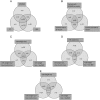The influence of different muscle mass measurements on the diagnosis of cancer cachexia
- PMID: 28447434
- PMCID: PMC5566652
- DOI: 10.1002/jcsm.12200
The influence of different muscle mass measurements on the diagnosis of cancer cachexia
Abstract
Background: Progressive loss of muscle mass is a major characteristic of cancer cachexia. Consensus definitions for cachexia provide different options to measure muscle mass. This study describes the effect of different methods to determine muscle mass on the diagnosis of cancer cachexia. In addition, the association of cachexia with other features of cachexia, quality of life, and survival was explored.
Methods: Prior to chemotherapy, cachexia was assessed by weight loss, body mass index, and muscle mass measurements, the latter by mid-upper arm muscle area (MUAMA), computed tomography (CT) scans, and bio-electrical impedance analysis (BIA). In addition, appetite, inflammation, muscle strength, fatigue, quality of life, and survival were measured, and associations with cachexia were explored.
Results: Included were 241 patients with advanced cancer of the lung (36%), colon/rectum (31%), prostate (18%), or breast (15%). Mean age was 64 ± 10 years; 54% was male. Prevalence of low muscle mass was as follows: 13% with MUAMA, 59% with CT, and 93% with BIA. In turn, the prevalence of cachexia was 37, 43, and 48%, whereby weight loss >5% was the most prominent component of being defined cachectic. Irrespective of type of muscle measurement, patients with cachexia presented more often with anorexia, inflammation, low muscle strength, and fatigue and had lower quality of life. Patients with cachexia had worse overall survival compared with patients without cachexia: HRs 2.00 (1.42-2.83) with MUAMA, 1.64 (1.15-2.34) with CT, and 1.50 (1.05-2.14) with BIA.
Conclusions: Although the prevalence of low muscle mass in patients with cancer depended largely on the type of muscle measurement, this had little influence on the diagnosis of cancer cachexia (as the majority of patients was already defined cachectic based on weight loss). New studies are warranted to further elucidate the additional role of muscle measurements in the diagnosis of cachexia and the association with clinical outcomes.
Keywords: Cachexia; Cancer; Muscle mass.
© 2017 The Authors. Journal of Cachexia, Sarcopenia and Muscle published by John Wiley & Sons Ltd on behalf of the Society on Sarcopenia, Cachexia and Wasting Disorders.
Figures


Similar articles
-
Relevance of the new pre-cachexia and cachexia definitions for patients with rheumatoid arthritis.Clin Nutr. 2012 Dec;31(6):1008-10. doi: 10.1016/j.clnu.2012.05.012. Epub 2012 Jun 12. Clin Nutr. 2012. PMID: 22695407
-
Measurement of body mass by bioelectrical impedance analysis and computed tomography in cancer patients with malnutrition - a cross-sectional observational study.Medicine (Baltimore). 2020 Dec 11;99(50):e23642. doi: 10.1097/MD.0000000000023642. Medicine (Baltimore). 2020. PMID: 33327343 Free PMC article.
-
Influence of additional criteria from a definition of cachexia on its prevalence--good or bad thing?Eur J Clin Nutr. 2013 Aug;67(8):797-801. doi: 10.1038/ejcn.2013.121. Epub 2013 Jul 3. Eur J Clin Nutr. 2013. PMID: 23820338
-
Effects of weight loss and sarcopenia on response to chemotherapy, quality of life, and survival.Nutrition. 2019 Nov-Dec;67-68:110539. doi: 10.1016/j.nut.2019.06.020. Epub 2019 Jun 28. Nutrition. 2019. PMID: 31522087 Review.
-
Cancer cachexia: molecular mechanism and pharmacological management.Biochem J. 2021 May 14;478(9):1663-1688. doi: 10.1042/BCJ20201009. Biochem J. 2021. PMID: 33970218 Review.
Cited by
-
Diagnostic Criteria for Cancer-Associated Cachexia: Insights from a Multicentre Cohort Study.J Cachexia Sarcopenia Muscle. 2025 Feb;16(1):e13703. doi: 10.1002/jcsm.13703. J Cachexia Sarcopenia Muscle. 2025. PMID: 39949111 Free PMC article.
-
Association between skeletal muscle mass and quality of life in adults with cancer: a systematic review and meta-analysis.J Cachexia Sarcopenia Muscle. 2022 Apr;13(2):839-857. doi: 10.1002/jcsm.12928. Epub 2022 Feb 13. J Cachexia Sarcopenia Muscle. 2022. PMID: 35156342 Free PMC article.
-
Phenotypic features of cancer cachexia-related loss of skeletal muscle mass and function: lessons from human and animal studies.J Cachexia Sarcopenia Muscle. 2021 Apr;12(2):252-273. doi: 10.1002/jcsm.12678. Epub 2021 Mar 30. J Cachexia Sarcopenia Muscle. 2021. PMID: 33783983 Free PMC article. Review.
-
Nutrition challenges of cancer cachexia.JPEN J Parenter Enteral Nutr. 2021 Nov;45(S2):16-25. doi: 10.1002/jpen.2287. JPEN J Parenter Enteral Nutr. 2021. PMID: 34897740 Free PMC article. Review.
-
Prognostic impact of cachexia by multi-assessment in older adults with heart failure: FRAGILE-HF cohort study.J Cachexia Sarcopenia Muscle. 2023 Oct;14(5):2143-2151. doi: 10.1002/jcsm.13291. Epub 2023 Jul 11. J Cachexia Sarcopenia Muscle. 2023. PMID: 37434419 Free PMC article.
References
-
- Thoresen L, Frykholm G, Lydersen S, Ulveland H, Baracos V, Birdsell L, et al. The association of nutritional assessment criteria with health‐related quality of life in patients with advanced colorectal carcinoma. Eur J Cancer Care (Engl) 2012;21:505–516. - PubMed
-
- Thoresen L, Frykholm G, Lydersen S, Ulveland H, Baracos V, Prado C, et al. Nutritional status, cachexia and survival in patients with advanced colorectal carcinoma. Different assessment criteria for nutritional status provide unequal results. Clin Nutr 2013;32:65–72. - PubMed
-
- Vigano A, Del Fabbro E, Bruera E, Borod M. The cachexia clinic: from staging to managing nutritional and functional problems in advanced cancer patients. Crit Rev Oncog 2012;17:293–303. - PubMed
-
- Blum D, Stene G, Solheim T, Fayers P, Hjermstad M, Baracos V, et al. Validation of the Consensus‐Definition for Cancer Cachexia and evaluation of a classification model—a study based on data from an international multicentre project (EPCRC‐CSA). Ann Oncol 2014;25:1635–1642. - PubMed
Publication types
MeSH terms
LinkOut - more resources
Full Text Sources
Other Literature Sources

